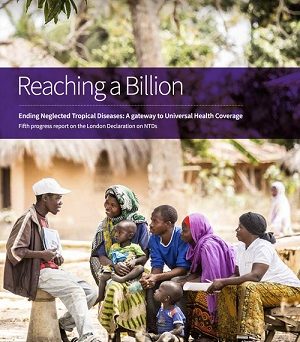
In London in 2012, pharmaceutical companies, donors, NTD-affected countries and NGOs signed the London Declarations on Neglected Tropical Diseases, recognising that no one organisation alone can eliminate NTDs but, by committing to work together, the control, elimination or potential eradication of 10 diseases by 2020 is feasible. Uniting to Combat NTDs is a collective of the dedicated partners whose aim is to strengthen advocacy and accountability in achieving these overarching goals. Every year they release a report measuring the progress made on these 10 diseases against the targets of control and/or elimination by 2020. On the 14th of December 2017, UTC released their 5th report which can be found here.
Some of the highlights of the report are:
Treatments: Thanks to the huge investments and donations from the pharmaceutical industry and through private-public partnerships a total of 1.8 billion treatments were donated in 2016, and 2017 saw a Guinness-world record in the largest number of drugs donated in a single day. These donated drugs are the backbone of many NTD control programmes and contributed to these amazing achievements:
- One billion people treated for at least one NTD in 2016.
- 400 million fewer people require preventative chemotherapy for NTDs compared to 2012.
NTDs: The report documents some fantastic highlights from individual NTDs:
- Trachoma eliminated in 5 countries since 2012, including Morocco in 2016 and Mexico on 2017.
- In 2017 lymphatic filariasis was eliminated in in 4 countries including Togo, the first sub-Saharan African country.
- Onchocerciasis has been eliminated in 4 countries since 2012.
Funding: This year saw some fantastic news regarding funding and investments in NTD control!
At the NTD summit in April 2017, $812million was pledged by donors: $450million over 5 years from the UK government DFID, 27million from the Belgium government and $335 million from the Gates foundation. USAID has been donating $100million per year over a 4 year period. In addition, a $100 million fund has been set up by the Crown Prince of Abu Dhabi, Sheikh Mohamed bin Zayed Al Nahyan, for the elimination of river blindness and lymphatic filariasis and $4million from the Kuwait Fund to support WHO AFRO ESPEN (Expanded Special Project for Elimination of Neglected Tropical Diseases).
Schistosomiasis News and Progress
Focusing on my favourite disease, whilst schistosomiasis remains prevalent with challenges to overcome (highlighted in the UTC 5th progress report), there have been considerable achievements made:
“The data show substantial progress in 2016 to reach almost 54% global coverage, with an impressive 57% coverage in the African Region due to expansion of control interventions,” said Dr Ren Minghui, WHO Assistant Director-General for Communicable Diseases. “The global target set in WHO’s roadmap on neglected tropical diseases is to reach at least 75% of all school-age children in endemic areas by 2020.“
- The WHO reports considerable progress in the percentage coverage of school-aged children reached; over 70million of them were treated for schistosomiasis in 2016. The WHO also highlighted the need to reach girls and women of reproductive-age to prevent them from developing Female Genital Schistosomiasis, a dangerous pathological manifestation of the disease that can persist even post infection and can have serious consequences!
- The recently published 2016 study on the Global Burden of Disease highlights that numbers of people affected by the schistosomiasis has considerably reduced since 2006! Out of all the NTDs schistosomiasis, together with onchocerciasis, got a special mention as two diseases in the low socio-demographic group showing the largest reduction in years living with disease (YLDs), a measurement of the burden of disease. The estimated number of people infected in 2016 is between 180 and 200 million people, considerable less than the estimated 260 million people in 2006. For that we owe our sincerest thanks to the stalwarts of the schistosomiasis control world (you know who you are!) and to the many individuals, governments and NGOs that have joined the fight!
“Between 2006 and 2016, there were large drops in age-standardised rates of YLDs for malaria, HIV/AIDS, onchocerciasis, and schistosomiasis in the low-SDI [socio-demographic index] quintile”
- The Pediatric Praziquantel Consortium has announced a joint GHIT & EDCTP funding of the Phase III clinical study on the pediatric praziquantel formulation. This excellent news means we are making great strides to attaining a suitable treatment for infants and pre-school aged children!
- The WHO operational manual on snail control using molluscicide was published this year and two snail control training workshops were organised, one in West Africa and one in East Africa. Furthermore a new NNN (NTD-NGO network) working group on Integrated Vector Control has been launched to advocate the integration of vector control in diseases control programmes and fitting in with the new NNN BEST (Behaviour, Environment, Social Inclusion, Treatment) framework.
The progress made on NTD control and elimination is impressive, however, even in the light of all this good news there is no time to become complacent. Innovative research in the field of parasites and vectors arms us with better diagnostics, better interventions, better strategies and stronger partners to combat these infections and mitigate the damage they cause.
(This post has been amended from the original blog post on the Global Schistosomiasis Alliance website)

Comments